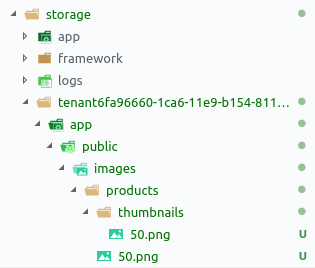Tenancy bootstrappers
Tenancy bootstrappers are classes which make your application tenant-aware in such a way that you don't have to change a line of your code, yet things will be scoped to the current tenant.
The package comes with these bootstrappers out of the box:
Database tenancy bootstrapper
The database tenancy bootstrapper switches the default database connection to tenant after it constructs the connection for that tenant.
Note that only the default connection is switched. If you use another connection explicitly, be it using DB::connection('...'), a model getConnectionName() method, or a model trait like CentralConnection, it will be respected. The bootstrapper doesn't force any connections, it merely switches the default one.
Cache tenancy bootstrapper
The cache tenancy bootstrapper replaces the Laravel's CacheManager instance with a custom CacheManager that adds tags with the current tenant's ids to each cache call. This scopes cache calls and lets you selectively clear tenants' caches:
php artisan cache:clear --tag=tenant_123
Note that you must use a cache store that supports tagging, e.g. Redis.
Filesystem tenancy bootstrapper
The filesystem bootstrapper makes your app's Storage facade and the storage_path() and asset() helpers tenant-aware by modifying the paths they return.
Note: If you want to bootstrap filesystem tenancy differently (e.g. provision an S3 bucket for each tenant), you can absolutely do that. Take a look at the package's bootstrappers to get an idea of how to write one yourself, and feel free to implement it any way you want.
Storage path helper
The bootstrapper suffixes the path returned by storage_path() to make the helper tenant-aware.
- The suffix is built by appending the tenant key to your
suffix_base. Thesuffix_baseistenantby default, but feel free to change it in thetenancy.filesystemconfig. For example, the suffix will betenant42if the tenant's key is42and thesuffix_baseistenant. - After the suffixing,
storage_path()helper returns"/$path_to_your_application/storage/tenant42/"
Since storage_path() will be suffixed, your folder structure will look like this:

Logs will be saved in storage/logs regardless of any changes to storage_path() and regardless of the tenant.
Storage facade
The bootstrapper also makes the Storage facade tenant-aware by suffixing the roots of disks listed in config('tenancy.filesystem.disks') and by overriding the disk roots in config('tenancy.filesystem.root_override') (disk root = the disk path used by the Storage facade).
The root of each disk listed in config('tenancy.filesystem.disks') will be suffixed. Doing that alone could cause unwanted behavior since Laravel does its own suffixing, so the filesystem config has the root_override section, which lets you override the disk roots after tenancy has been initialized:
// Tenancy config (tenancy.filesystem.root_override)
// %storage_path% gets replaced by storage_path()'s output
// E.g. Storage::disk('local')->path('') will return "/$path_to_your_application/storage/tenant42/app"
// (Given a suffix_base of 'tenant' and a tenant with a key of `42`. Same as in the example above in the Storage path helper section)
'root_override' => [
'local' => '%storage_path%/app/',
'public' => '%storage_path%/app/public/',
],
To make the tenant-aware Storage facade work with a custom disk, add the disk's name to config('tenancy.filesystem.disks') and if the disk is local, override its root in config('tenancy.filesystem.root_override') as shown above. With S3, overriding the disk roots is not necessary – Storage::disk('s3')->path('foo.txt') will return /tenant42/foo.txt.
Assets
The filesystem bootstrapper makes the asset() helper link to the files of the current tenant. By default, the bootstrapper makes the helper output a URL pointing to the TenantAssetsController (/tenancy/assets/...), which returns a file response:
// TenantAssetsController
return response()->file(storage_path('app/public/' . $path));
The package expects the assets to be stored in your tenant's app/public/ directory. For global assets (non-private assets shared among all tenants), you may want to create a disk and use URLs from that disk instead. For example:
Storage::disk('branding')->url('header-logo.png');
To access global assets such as JS/CSS assets, you can use global_asset() and mix().
Configuring the asset URL (ASSET_URL in your .env) changes the asset() helper's behavior – when the asset URL is set, the bootstrapper will suffix the configured asset URL (the same way storage_path() gets suffixed), and make the asset() helper output that instead of a path to the TenantAssetsController.
You can disable tenancy of asset() in the config (tenancy.filesystem.asset_helper_tenancy) and explicitly use tenant_asset() instead. tenant_asset() always returns a path to the TenantAssetController: tenant_asset('foo.txt') returns your-site.com/tenancy/assets/foo.txt. You may want to do that if you're facing issues using a package that utilizes asset() inside the tenant app.
Before using the asset() helper, make sure to assign the identification middleware you're using in your app to TenantAssetsController's $tenancyMiddleware:
// TenancyServiceProvider (don't forget to import the classes)
public function boot()
{
// Update the middleware used by the asset controller
TenantAssetsController::$tenancyMiddleware = InitializeTenancyByDomainOrSubdomain::class;
}
Queue tenancy bootstrapper
This bootstrapper adds the current tenant's ID to the queued job payloads, and initializes tenancy based on this ID when jobs are being processed.
The bootstrapper has a static $forceRefresh property which is false by default. Setting the property to true will make tenancy re-initialize for each queued job. This is useful when you're changing the tenant's state (e.g. properties in the data column) and want the next job to initialize tenancy again with the new data. Features like the Tenant Config are only executed when tenancy is initialized, so the re-initialization is needed in some cases.
You can read more about this on the Queues page:
Redis tenancy bootstrapper
If you're using Redis calls (not cache calls, direct Redis calls) inside the tenant app, you will want to scope Redis data too. To do this, use this bootstrapper. It changes the Redis prefix for each tenant.
Note that you need phpredis, predis won't work.
Writing custom bootstrappers
If you want to bootstrap tenancy for something not covered by this package — or something covered by this package, but you want different behavior — you can do that by creating a bootstrapper class.
The class must implement the Stancl\Tenancy\Contracts\TenancyBootstrapper interface:
namespace App;
use Stancl\Tenancy\Contracts\TenancyBootstrapper;
use Stancl\Tenancy\Contracts\Tenant;
class MyBootstrapper implements TenancyBootstrapper
{
public function bootstrap(Tenant $tenant)
{
// ...
}
public function revert()
{
// ...
}
}
Then, register it in the tenancy.bootstrappers config:
'bootstrappers' => [
Stancl\Tenancy\Bootstrappers\DatabaseTenancyBootstrapper::class,
Stancl\Tenancy\Bootstrappers\CacheTenancyBootstrapper::class,
Stancl\Tenancy\Bootstrappers\FilesystemTenancyBootstrapper::class,
Stancl\Tenancy\Bootstrappers\QueueTenancyBootstrapper::class,
App\MyBootstrapper::class,
],
